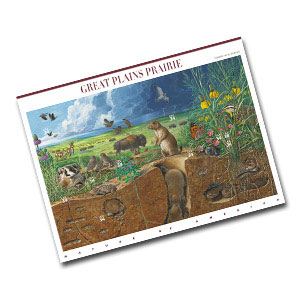|
|  |  |  |
 
Issued April 19, 2001,
Lincoln, NE 68501 |
 |
 Painted by John D. Dawson of Hilo, Hawaii, the artwork includes 25 animal and plant species native to the mixed-grass prairie of the American Great Plains. The artwork illustrates both the immense scale of the ecosystem and the individual environments of many important species. While the scene is imaginary, all species represented are appropriate and were recommended by scientists. A description of the prairie and a list of the common and Latin names of the plants and animals included in the art appear on the back of the stamp pane. |
|
